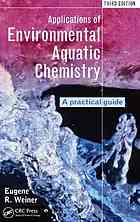

Most ebook files are in PDF format, so you can easily read them using various software such as Foxit Reader or directly on the Google Chrome browser.
Some ebook files are released by publishers in other formats such as .awz, .mobi, .epub, .fb2, etc. You may need to install specific software to read these formats on mobile/PC, such as Calibre.
Please read the tutorial at this link: https://ebookbell.com/faq
We offer FREE conversion to the popular formats you request; however, this may take some time. Therefore, right after payment, please email us, and we will try to provide the service as quickly as possible.
For some exceptional file formats or broken links (if any), please refrain from opening any disputes. Instead, email us first, and we will try to assist within a maximum of 6 hours.
EbookBell Team

4.0
96 reviews"Preface to the Third Edition The chemical makeup of a collected water sample reflects the history of its prior flow path, particularly the minerals it has contacted, its contact time with these minerals, and the values of temperature, pH, and redox potential along the flow path. Many environmental chemistry books can be put into one of two groups: 1. Those that are very thorough and include nearly all of the basic chemical principles that underlie the topics covered. 2. Those that rely on an existing understanding of the basic principles and begin from there. This text tries to follow a middle path, where the basic principles needed for an environmental topic are included only to the extent of contributing to an understanding of the topic being discussed and to guide the reader in applying the information to actual environmental problems. The fields of environmental science and engineering advance rapidly. This third edition is substantially updated (Photo courtesy of Gary Witt) viii Preface to the Third Edition from the second edition. Besides extensive reorganization and updating, there is a new chapter "Nutrients and Odors: Nitrogen, Phosphorus, and Sulfur," two new appendices "Solubility of Slightly Soluble Metal Salts" and "Glossary of Acronyms and Abbreviations Used in this Book," and much new material, especially in Chapters 5 and 11 and in Appendix A."--
"Preface to the Third Edition The chemical makeup of a collected water sample reflects the history of its prior flow path, particularly the minerals it has contacted, its contact time with these minerals, and the values of temperature, pH, and redox potential along the flow path. Many environmental chemistry books can be put into one of two groups: 1. Those that are very thorough and include nearly all of the basic chemical principles that underlie the topics covered. 2. Those that rely on an existing understanding of the basic principles and begin from there. This text tries to follow a middle path, where the basic principles needed for an environmental topic are included only to the extent of contributing to an understanding of the topic being discussed and to guide the reader in applying the information to actual environmental problems. The fields of environmental science and engineering advance rapidly. This third edition is substantially updated (Photo courtesy of Gary Witt) viii Preface to the Third Edition from the second edition. Besides extensive reorganization and updating, there is a new chapter "Nutrients and Odors: Nitrogen, Phosphorus, and Sulfur," two new appendices "Solubility of Slightly Soluble Metal Salts" and "Glossary of Acronyms and Abbreviations Used in this Book," and much new material, especially in Chapters 5 and 11 and in Appendix A."